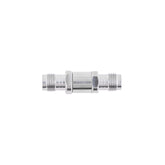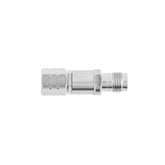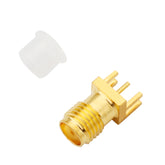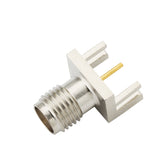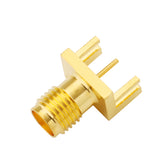How to select SMA connector?
SMA connectors are widely used in microwave systems, radio and mobile antennas, WiFi devices, and other applications that require high-frequency signals. SMA connectors are semi-precision coaxial RF connectors that have a 50 ohm impedance and a screw-type coupling mechanism. They can provide excellent electrical performance from DC to 18 GHz, and some variants can operate up to 26.5 GHz or even 40 GHz.

However, not all SMA connectors are the same. There are different types, sizes, materials, and specifications of SMA connectors that suit different purposes and requirements. Therefore, it is important to know how to select the right SMA connector for your project. Here are some factors that you should consider when choosing an SMA connector:
• Cable type and size: SMA connectors can terminate to various types of coaxial cables, such as flexible, low-loss, semi-rigid, and conformable cables. However, not every SMA connector can fit every cable. You need to check the compatibility of the SMA connector and the cable in terms of the diameter, impedance, and frequency range.
• Polarity: SMA connectors have two types of polarity: standard and reverse. Standard SMA connectors have a male pin in the male connector and a female sleeve in the female connector. Reverse SMA connectors have the opposite arrangement: a female pin in the male connector and a male sleeve in the female connector. The polarity of the SMA connector determines how it can mate with other SMA connectors or devices. You need to make sure that the polarity of the SMA connector matches the polarity of the device or cable that you want to connect.
• Material and plating: SMA connectors are usually made of brass or stainless steel, and plated with gold, nickel, or passivated. The material and plating of the SMA connector affect its durability, corrosion resistance, and electrical performance. Generally, stainless steel SMA connectors are more robust and can withstand higher temperatures and pressures than brass SMA connectors. Gold-plated SMA connectors have better conductivity and lower contact resistance than nickel-plated or passivated SMA connectors. However, the material and plating of the SMA connector also affect its cost and availability.
• Performance and specifications: SMA connectors have various performance and specifications that indicate their electrical and mechanical characteristics. Some of the common parameters that you should pay attention to are:
• Frequency range: The frequency range of the SMA connector shows the maximum frequency that the connector can operate without significant signal loss or distortion. The frequency range of the SMA connector depends on the type, size, and material of the connector and the cable. Typically, SMA connectors can work from DC to 18 GHz, but some extended range designs can go up to 26.5 GHz or 40 GHz.
• Voltage rating: The voltage rating of the SMA connector shows the maximum voltage that the connector can withstand without breaking down or arcing. The voltage rating of the SMA connector depends on the dielectric material and the spacing between the contacts. Typically, SMA connectors can handle up to 335 volts RMS continuous. You need to choose an SMA connector that can handle the voltage level of your application.https://www.amphenolrf.com/rf-connectors/sma-connectors.html
• VSWR (Voltage Standing Wave Ratio): The VSWR of the SMA connector shows the ratio of the reflected power to the incident power at the connector interface. The VSWR of the SMA connector indicates how well the connector matches the impedance of the cable and the device. A lower VSWR means a better match and a lower signal loss. Typically, SMA connectors have a VSWR of 1.05 to 1.20 depending on the cable type and the frequency. You need to choose an SMA connector that has a low VSWR for your application.https://www.amphenolrf.com/rf-connectors/sma-connectors.html
• Insertion loss: The insertion loss of the SMA connector shows the amount of power loss that occurs when the connector is inserted into the signal path. The insertion loss of the SMA connector depends on the frequency, the cable type, and the quality of the connector. A lower insertion loss means a higher signal transmission efficiency. Typically, SMA connectors have an insertion loss of 0.06 to 0.15 dB depending on the frequency. You need to choose an SMA connector that has a low insertion loss for your application.https://www.amphenolrf.com/rf-connectors/sma-connectors.html
• Power handling: The power handling of the SMA connector shows the maximum power that the connector can transmit without damaging the connector or the cable. The power handling of the SMA connector depends on the frequency, the cable type, and the temperature. A higher power handling means a higher signal strength and a lower distortion. Typically, SMA connectors can handle up to 75 W at 10 GHz at 25°C. You need to choose an SMA connector that can handle the power level of your application.https://www.amphenolrf.com/rf-connectors/sma-connectors.html
These are some of the main factors that you should consider when selecting an SMA connector. Of course, there may be other factors that are specific to your project or application, such as the mating cycles, the coupling mechanism, the environmental conditions, and the cost.

